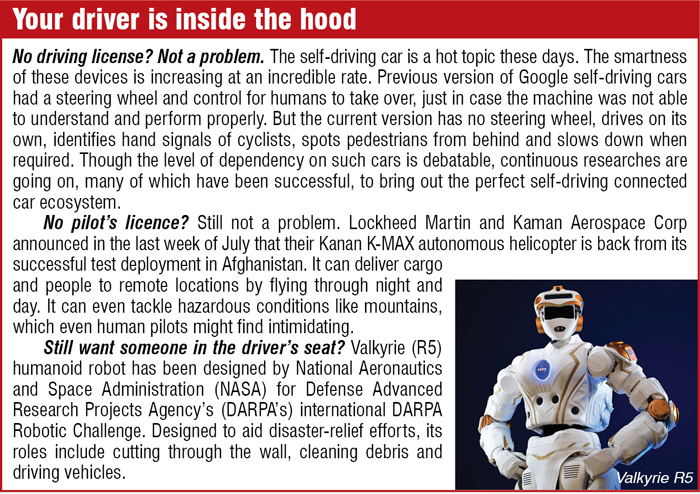While most of these technologies can be connected to those used in other autonomous robots, safety is critical for the automotive robots, so these have lot more policies and regulations to consider while operating. This also applies to the ruggedness of the electronics that they use. The fact that electronics in vehicles has increased a lot over the years is an obvious point now that cars were some of the hottest attractions at the International Consumer Electronics Show (CES) 2014.
Sensors that empower self-driving cars have started showing up in mid-range cars for limited uses, like ultrasonic systems and front-mounted radar for adaptive cruise control. Automakers are making the most of this by using the concept of sensor fusion to combine data from different sensor systems and cameras to enable the car to make a decision before the driver even knows what’s happening.
In a report on CNN, Dr Werner Huber, BMW project manager driver, spoke about how the car is now becoming a driving and moving robot. And the Federal Bureau of Investigation (FBI) feels that driverless cars could be used as lethal weapons, as per a report released by their Strategic Issues Group.
Step five to world domination: replace humans
What the industrial revolution did to manual labourers in the last century is being done to knowledge-workers (like you and me) now. Medical industry is also witnessing breakthrough innovations powered by robotics. “Most of the intelligent systems introduced in medical industry are still under trial and not certified yet to be used widespread,” says Satish Mohanram of NI, “but the applications in these fields are huge.” One such possibility is a system that can diagnose a medical condition and prescribe remedies for the situation. It could potentially perform telemedicine on its own.

Not all robots that replace humans are humanoid though. A human sperm-shaped, tiny (322µm long, 5.2µm wide and 42µm thick), swimming microbot with a magnetic head is a competitor with the most senior of doctors for performing surgery. Armed with a 200nm cobalt-nickel layer, this little fellow creates a dipole moment that allows this flexible structure to align along weak oscillating magnetic field lines, and hence generate a propulsion mechanism. This robot, named as MagnetoSperm, could assist targeted drug delivery, in-vitro fertilisation and even perform minimally invasive surgeries.

It is not just doctors that could get replaced, robots can affect even gourmet chefs. San Francisco-based Momentum Machines has a robot that occupies just 155 square centimetre (24 square inch) space. This robot takes customised orders and produces around 360 gourmet burgers per hour. Since the burgers are produced entirely by the machine and untouched by human hands, it is more sanitary. Higher productivity, lower cost (except the initial investment) and consistency are some other features of this machine.
What the future holds
At this rate, we are soon approaching the retro-future depicted in The Jetsons and WALL·E. Robots taking up human jobs could mean not only faster, better and cheaper services but, perhaps, also unemployment and lower wages for existing employees. Well we are facing a question very similar to what we did when computers were first introduced into the mainstream.
Perhaps it is time to think of the possibilities for working in a world where robots perform major tasks and are even judged as being better than humans. After all, they don’t have emotional problems, criminal tendencies or try to understand the meaning of life. Yet.
Dilin Anand is a senior assistant editor at EFY.
Anagha P is a dancer, karaoke aficionado, and a technical correspondent at EFY. Find her on Twitter @AnuBomb.






